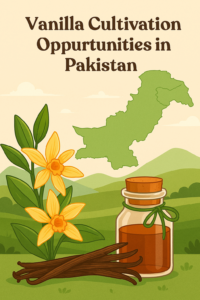Introduction to Vanilla Cultivation
Vanilla is a sought-after flavoring agent and is the second most expensive spice in the world, after saffron. Growing vanilla requires specific climatic conditions and thoughtful agricultural practices, making it an exciting opportunity for farmers in Punjab, Pakistan. Given the region’s favorable temperature and humidity, vanilla cultivation is emerging as a lucrative venture for local agriculture.
Benefits of Cultivating Vanilla
Cultivating vanilla in Punjab can offer several benefits. Firstly, it allows farmers to diversify their crops, reducing dependency on traditional products. Vanilla plants have a high market demand both locally and internationally, providing an excellent source of income. Additionally, as vanilla is a perennial crop, it offers sustainable returns over many years once established.

📋 Vanilla Cultivation Business Plan – Punjab, Pakistan
1. Executive Summary
- Objective: Establish a small-scale vanilla farm using shade-house cultivation.
- Location: Southern Punjab (e.g., Multan or Bahawalpur).
- Scale: 1 acre pilot project.
- Target Market: Gourmet food producers, boutique bakeries, export buyers.
2. Production Plan
- Crop: Vanilla planifolia.
- Method: Shade-house cultivation with drip irrigation.
- Pollination: Manual (essential for yield).
- Harvest Cycle: First yield in 2–3 years, peak productivity by year 4.
3. Cost Estimation (1 Acre Pilot)
Here’s a detailed breakdown of the estimated cost to cultivate vanilla on 1 acre in Punjab, Pakistan, assuming a shade-house setup with drip irrigation and manual pollination:
💰 Vanilla Cultivation Cost Estimate – 1 Acre in Punjab
| Expense Category | Estimated Cost (PKR) | Notes |
|---|---|---|
| Land Preparation | 300,000 | Includes leveling, soil testing, organic enrichment. |
| Shade Net Structure | 900,000 | Essential for controlling light and humidity. |
| Vanilla Seedlings (1,000+) | 500,000 | High-quality Vanilla planifolia cuttings or tissue culture plants. |
| Drip Irrigation System | 300,000 | Efficient water management; includes pipes, pump, and filters. |
| Labor & Training | 400,000/year | Skilled labor for pollination, vine training, and maintenance. |
| Fertilizers & Pest Control | 150,000/year | Organic inputs preferred; includes compost, neem oil, etc. |
| Post-Harvest Processing | 250,000 | Curing, drying, and packaging setup. |
| Marketing & Branding | 200,000 | Labels, local outreach, and export readiness. |
| Miscellaneous & Contingency | 150,000 | Unexpected costs, repairs, or upgrades. |
| Total Estimated Cost (Year 1) | 3,150,000 PKR (~USD 11,000) | Initial setup; recurring costs reduce after year 3. |
4. Revenue Potential
- Yield: ~500–600 kg of cured vanilla beans by year 4.
- Market Price: PKR 20,000–30,000/kg (premium grade).
- Projected Revenue: PKR 10–18 million annually (from year 4 onward).
5. Risk & Mitigation
- Risk: Long maturation period, labor-intensive pollination.
- Mitigation: Start with a pilot, train local labor, explore agri-tech support.
📈 Long-Term Outlook
- Year 1–2: Setup and vine establishment.
- Year 3: First small harvest.
- Year 4 onward: Full yield potential (~500–600 kg cured beans).
- Revenue Potential: PKR 10–18 million/year depending on quality and market access.
Challenges and Considerations
Though the potential of vanilla cultivation in Punjab is promising, there are challenges to consider. Vanilla is a climbing orchid that requires specific support structures for growth. Farmers must also focus on proper pollination techniques and pest management to ensure a healthy harvest. Understanding these requirements is crucial for anyone interested in taking advantage of vanilla cultivation opportunities in the region.
In conclusion, with the right knowledge and resources, Punjab can become a significant player in vanilla production, beneficially impacting the local economy. By embracing modern agricultural techniques, farmers can tap into this golden opportunity and elevate their farming practices.

